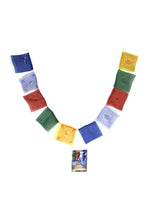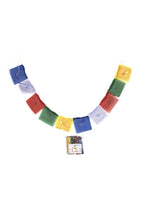Size Small: approx 48"x4 1/2"
Size Large: approx 68"x6"
Here are 5 things you might like to know about Tibetan prayer flags.
1. When you are hanging prayer flags have good intentions
When raising prayer flags it is important to have a good motivation. You should not have selfish or limiting thoughts. When hanging prayer flags, wish that all beings everywhere will benefit and find happiness.
Tibetan prayer flags are used to promote peace, compassion, strength, and wisdom. Tibetans believe the prayers and mantras printed on the flags will be spread by the wind and bring goodwill and compassion to benefit all beings.
2. Each of the 5 colors has a meaning
Tibetan prayer flags come in sets of five, with one flag in each of the five colors. The colors from left to right are in this specific order: blue, white, red, green, and yellow.
Each color represents an element.
– Blue symbolizes the sky and space.
– White symbolizes the air and wind.
– Red symbolizes fire.
– Green symbolizes water.
– Yellow symbolizes earth.
Some people have asked whether it is OK to disassemble sets of prayer flags and use them separately. It is better not to take apart the set of prayer flags. They represent the five elements in balance and it is not appropriate to the purpose or culture to separate them. Instead, you might choose to double them back or allow the remaining flags to hang down without touching the ground.
3. You should treat prayer flags with respect
Tibetans consider prayer flags to be holy. The flags contain sacred texts and symbols and should always be treated respectfully. They should not touch the ground or be put in the trash.
When disposing of old prayer flags, you should safely burn them so that the smoke may carry their blessings to the heavens. Again, do not let prayer flags touch the ground as they are burned.
As you are burning the prayer flags, remember the intentions with which the prayer flags were made, blessed, and hung. You should have compassion for all sentient beings.
You may also choose to let your old Tibetan prayer flags fade and disintegrate. If you wish, you can hang new prayer flags together with old ones. The contrast between old and new is a reminder of impermanence and the continuing cycle of birth and death.
The traditional cotton prayer flags, like those made by the nuns at Dolma Ling, fade more quickly than synthetic ones and come on a cotton string. The fact that they do not last is part of their nature and is a reminder of the central Buddhist teaching of impermanence.
4. You don’t have to be a Buddhist to hang prayer flags
Some people have asked whether it is OK for non-Buddhists to display Tibetan prayer flags. Yes, it is fine. Again, your motivation and intentions are key. Hang them with a wish for all beings to be free of suffering and the causes of suffering, or for a positive intention of your choice.
5. There are different types and sizes of prayer flags
Prayer flags are made of block-printed fabric using traditional printing techniques going back hundreds of years. They come in various types and sizes.
The most common types are square or rectangular and connected along their top edges to a long string. They are hung on a straight or diagonal line between two objects and in high places such as the tops of temples, monasteries, stupas, and mountain passes.
Another type of prayer flag is called Darchog. These vertical prayer flags are usually large single rectangles attached to poles along their vertical edge. Darchog are commonly planted in the ground, mountains, cairns, or on rooftops.
The Windhorse or Lung-ta is the most common type of prayer flag. In the center of each prayer flag is the symbol of a powerful horse (lung-ta in Tibetan) bearing three flaming jewels on its back. The triple gem or three jewels represent the Buddha, the dharma (the teachings), and the sangha (the community of practitioners).
The horse (ta in Tibetan) is a symbol of speed and the transformation of bad fortune to good fortune. Surrounding the lung-ta are mantras and Buddhist sacred symbols. In the corners of the prayer flags are images of four powerful animals, also known as the Four Dignities: the dragon, the garuda, the tiger, and the snow lion.



